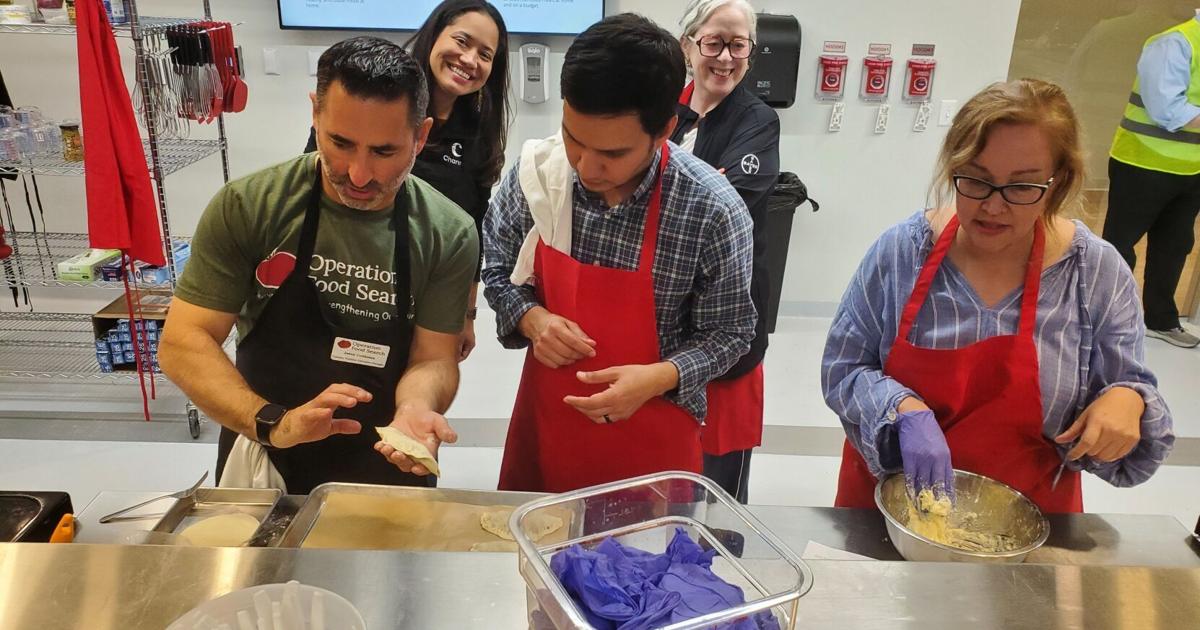
Daniel Neman | Post-Dispatch
Features writer
Get email notifications on {{subject}} daily!
Your notification has been saved.
There was a problem saving your notification.
{{description}}
Email notifications are only sent once a day, and only if there are new matching items.
Followed notifications
Please log in to use this feature
Log In
Don’t have an account? Sign Up Today
The ingredient often donated to food pantries, that they then find hardest to give away, is chickpeas.
Chickpeas have loads of flavor and are a great source of fiber, but people don’t know what to do with them.
Operation Food Search, a food bank, has a teaching kitchen that helps to solve that problem. In some of his classes, chef Jason Goldman shows the participants how to make a Thai coconut curry using red curry paste, coconut milk and chickpeas.
One woman at a recent class said she dislikes curry, coconut milk and chickpeas. She made the dish anyway, and now she loves it, Goldman says.
The teaching kitchen was recently built through the generosity of the Berges Family Foundation, which will cover the kitchen’s entire $500,000 cost. It is dedicated to cooking classes that use ordinary, easy-to-find ingredients that don’t hurt the budget.
“We’re teaching people to cook for themselves at home,” says Goldman, who is the nonprofit organization’s culinary nutrition education manager.
Teaching kitchens often rely on professional equipment, using special ingredients to create a meal unlike a typical dinner you would make or eat at home. Part of the thrill is the opportunity to cook on high-quality equipment, using the best available ingredients.
Operation Food Search’s teaching kitchen is the opposite of that. The eight stations — each can be manned by two people — use ordinary, residential GE electric flat-top stoves. The pots and pans are meant for home cooking. The knives come from Amazon; they are color-coded, so Goldman can tell the participants to use the yellow knife instead of risking confusion by referring to a chef’s knife or a paring knife.
Ordinary smaller appliances are used, too. The air fryers, instant pots, blenders and food processors are all good quality, he says, but they are designed and sold for home use instead of the more exacting demands of a professional kitchen.
The equipment should feel comfortable and familiar to the users. The idea is to keep the classes accessible, says Melissa Weissler, the chief program officer.
The classes are not just for people in need, the people who pick up the food from their local food pantries, though some of the classes are for them. Corporate groups looking for team-building, nonprofit groups learning the recipes so they can pass them on to their clients or even girls-night-out groups can all schedule a class.
For-profit groups and noncharitable organizations pay $750 for a one-hour class that can fit up to 16 participants. That covers the actual cost of the class and pays for a free class given to people in need. Nonprofit organizations are charged $375, which covers the actual cost of the class.
Goldman creates and chooses the recipes with an eye toward home cooking. One recent class featured a Mexican street corn bowl, with roasted corn (they roasted it on the stove themselves rather than buying frozen roasted corn), beans, feta cheese, cilantro, peppers and a sauce over quinoa.
Goldman prefers quinoa to rice. Not only does it offer a nutty flavor, but it also is full of protein and is more forgiving. You can overcook quinoa and it will still taste good, but overcooked rice is less desirable.
Sometimes, he looks for what he calls “lightbulb moments.”
Like chickpeas, kale is often overlooked at food pantries. Goldman suspects that is because people do not know what to do with it. So he created a recipe for kale pesto pasta.
The secret is that he very briefly blanches the kale in hot water, which turns it a bright green. He dries it off and then liquifies it in a food processor, which creates a velvety texture, he says. He adds garlic, Parmesan cheese and walnuts, blends them all together and creates a pesto that is both surprising and delicious.
Even so, according to Weissler, the recipe is not the main point of the classes.
“Cooking at home, in and of itself, is the most important thing we’re trying to teach here,” she says.
Be the first to know
Get local news delivered to your inbox!
* I understand and agree that registration on or use of this site constitutes agreement to its user agreement and privacy policy.
Daniel Neman | Post-Dispatch
Features writer
Get email notifications on {{subject}} daily!
Your notification has been saved.
There was a problem saving your notification.
{{description}}
Email notifications are only sent once a day, and only if there are new matching items.
Followed notifications
Please log in to use this feature
Log In
Don’t have an account? Sign Up Today



